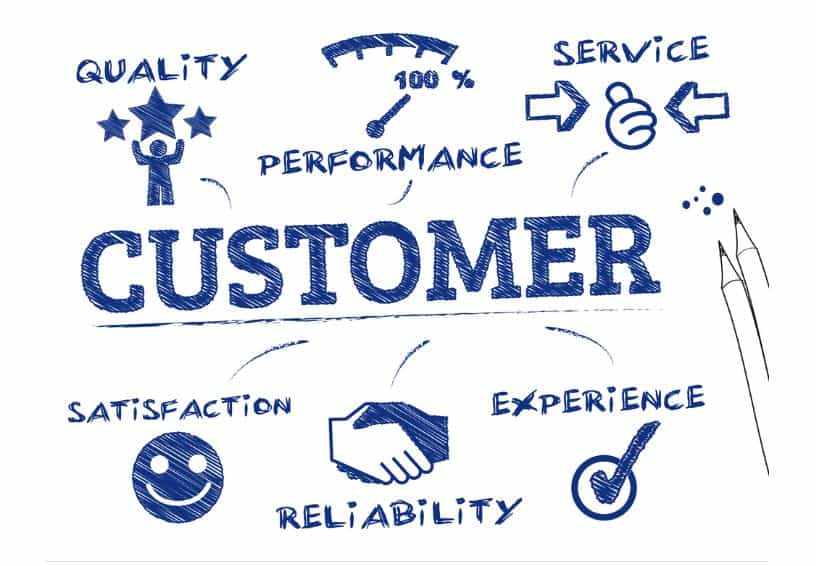The terms ‘customer service’ and ‘customer experience’ are frequently used in a company, but the workforce is usually unable to differentiate between them and tend to use them interchangeably. A business has to separate the terms to appear favorably in the eyes of customers.
The terms are related; however, there’s a significant difference between them as well.
What is customer service?
Customer service is when the company provides appropriate support to the consumers during different purchasing stages.
For example, before the purchase, helping the customer make an informed decision, making the process as easy as possible during the purchase. After the purchase, by following up for feedback or addressing any complaints the customer might have.
What are the components of customer service?
Several components are included in different areas of customer service. These components have to be followed appropriately for the customers to go through positive customer service.
Being courteous
A representative of the company has to be polite and courteous whether a consumer is trying to decide whether to buy the product or want a problem solved.
Professionalism along with personalization
Customers appreciate it when a company’s representatives maintain a level of professionalism while dealing with them. However, they also appreciate when there’s a personalized approach, such as a feedback call about the service or the product or a callback once a problem is solved to ensure the product is running smoothly.
Swift response
It’s universal knowledge that a customer dislikes being put on hold while waiting for a representative to answer the call or wait days for someone to come home to look at the device.
Customers appreciate when the response from the company is prompt regarding problem-solving or answering emails.
What is customer experience?
Customer experience is described as the holistic experience that a customer has with a company. This includes all aspects of customer service as well as other factors.
Let’s talk about an example. You, as a customer, come across a sponsored post on Facebook for a sweater. You visit the website, but you want to read more reviews as it’s your first experience.
You go on their Facebook or Instagram page and conduct thorough research. You also want some information regarding the sweater’s material and decide to interact with the brand on Facebook Messenger or via the live chat on the website.
This is a whole journey that you, as a customer, have made with the company regarding a product. Hence, customer experience is said to be a journey; a company may believe their overall brand image is immaculate; however, one customer’s experience might differ.
What are the main elements of customer experience?
The following are the main elements of customer experience, which help businesses provide an overall positive journey to a customer.
Analyze: A business has many departments. One of the departments works solely on the reception of their product. This includes analyzing customer behavior to utilize it for marketing.
Constant improvements: The data gathered above is used by businesses to improve their products to make it easier for customers to buy and use.
Customer-oriented approach: Most businesses have adopted a customer-oriented approach where the customer comes first. Because if the courteous attitude towards the customers is not adapted, then the business is going nowhere.
Differences between customer service and customer experience
Individualistic vs. Combined Approach
Customer service is considered only one aspect of service a company provides the customer with, such as solving a customer’s problem. On the other hand, customer experience is the amalgamation of all the services that a company provides to the customer on separate occasions; the overall experience.
Customer service is just one step of the journey, but customer experience includes everything, starting from the moment the customer became aware of the product’s existence. This can consist of the product’s marketing, packaging, accessibility, pricing, and many other things.
Focused vs. Holistic Attention
Every separate department has a customer service area. For example, in the sales department, short training is given to the sales representatives on approaching customers. The same goes for the department, which looks into the complaints by the customers.
The customer experience, however, is the collective service given to the customer. The company shouldn’t wait for a customer to react to the product by complaining but should take preventive measures.
Reactive vs. Proactive Measures
Apart from this, the company should know about the customers’ feelings beforehand, such as the reason they buy the products. This gives them an opportunity to build a positive experience from before instead of giving a reactive response. For this to happen, a company should be aware of the clientele they target; their needs, their feelings, and their reasons.
The company should use the clients’ past experiences to make the future experience even better. This means a company needs to adopt a proactive approach, as opposed to a reactive one. A customer experience is treated as a continuous event rather than a singular event.
Therefore, a company needs to provide ongoing training to the staff to be treated with the utmost respect and has a positive experience at every stage.
How to improve customer service and experience?
There are multiple things you can do to improve these critical aspects of your company, including:
- Provide ongoing training to the staff to guarantee the consistency of positive services.
- Conduct surveys to find out what attracts customers.
- Ask for feedback to ensure the customers’ loyalty.
Final Thoughts
Both terms are essential, not only as concepts but also crucial to implement. A company must strive to ensure it maintains a positive customer experience and service. Both concepts deal with customers on either a micro or a macro level; hence, the bottom line is the same.
Customers have to be treated well when interacting with, whether it is a reactive or proactive response. Almost all companies’ motto is that a customer is always right. The technicalities are another story.
Many companies have now moved on to artificial intelligence when dealing with customers. However, as mentioned above, a personalized touch is the key to ensuring a customer’s loyalty and the chances of returning.
Furthermore, this strategy also acts as a marketing tactic as these customers provide references to their family and friends to use the service or purchase the product.





